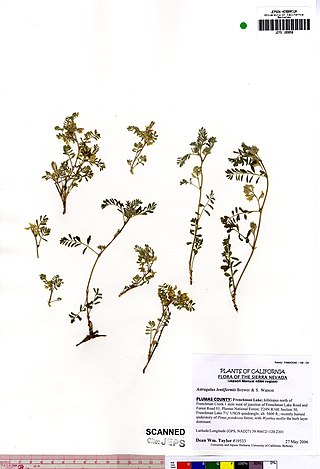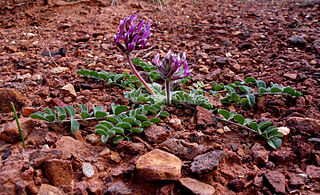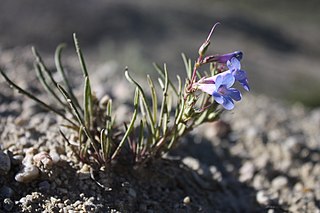
Astragalus albens is a species of milkvetch known by the common names Cushenbury milkvetch and silvery-white milkvetch.

Astragalus brauntonii is a rare species of milkvetch known by the common name Braunton's milkvetch. It is endemic to California, where it is known from fewer than 20 extant occurrences in the hills and mountains surrounding the Los Angeles Basin in Southern California. This is a federally listed endangered species in the United States.

Astragalus deanei is a rare species of milkvetch known by the common name Dean's milkvetch, or Deane's milkvetch. It is endemic to southern San Diego County, California, where it grows on the slopes of the Peninsular Ranges between El Cajon and Tecate.
Astragalus funereus is an uncommon species of milkvetch known by the common names Funeral Mountain milkvetch and black milkvetch.

Astragalus jaegerianus is a rare species of milkvetch known by the common name Lane Mountain milkvetch. The plant was named for the biologist Edmund Jaeger, who first documented it in 1939.

Astragalus lentiformis is a species of milkvetch known by the common name lens-pod milkvetch. It is endemic to the Sierra Nevada in eastern Plumas County, California, where it grows in chaparral scrub and coniferous forests.
Astragalus monoensis is a rare species of milkvetch known by the common name Mono milkvetch. It is endemic to the open pumice plains of central Mono County, California.

Astragalus purshii is a species of milkvetch known by the common names woollypod milkvetch and Pursh's milkvetch.

Astragalus pycnostachyus is a species of milkvetch known by the common name marsh milkvetch. It is endemic to the coastline of California, where it grows in wet saline habitat such as marshes.

Astragalus webberi is a rare species of milkvetch known by the common name Webber's milkvetch. It is endemic to the coniferous forests in the Sierra Nevada, in Plumas County, eastern California.

Astragalus desereticus is a rare species of milkvetch known by the common name Deseret milkvetch. It is endemic to Utah County, Utah, where it is known from only one population. It was thought to be extinct until 1981 when this population was discovered. The population contains 5,000 to 10,000 plants on an area of land covering less than 300 acres. It is vulnerable to damage from grazing cattle, which eat the plant and trample the soil, and from development and erosion. This is a federally listed threatened species.

Astragalus holmgreniorum is a rare species of milkvetch known by the common names Holmgren milk-vetch and paradox milk-vetch. It is native to a tiny section of desert shrub woodland on the border between Utah and Arizona, in the far northern Mojave Desert. There are six populations remaining. It is a federally listed endangered species.

Astragalus osterhoutii, or the Osterhout milkvetch or Kremmling milkvetch, is an endangered species of milkvetch, discovered and collected in 1905 at Sulfur Spring in Grand County Colorado by Colorado botanist George Everett Osterhout for which the plant was named. It is found in the U.S. state of Colorado, in a 13 kilometres (8.1 mi) radius near the town of Kremmling.

Penstemon penlandii is a rare species of flowering plant in the plantain family known by the common names Penland penstemon and Penland's beardtongue. It is endemic to Colorado in the United States, where it is known only from a strip of land about five miles long in central Grand County. There are two occurrences totalling about 8600 individuals. This is a federally listed endangered species of the United States.

Astragalus microcymbus is a species of flowering plant in the legume family known by the common name Skiff Milkvetch. It is endemic to Colorado in the United States, where it is known from Gunnison County and the edge of Saguache County. It was discovered in 1945 by Rupert Barneby, a British botanist. Currently, Skiff Milkvetch is experiencing population declines and is listed as Threatened.

Astragalus mulfordiae is a species of flowering plant in the legume family known by the common name Mulford's milkvetch. It was so named after its discoverer Anna Isabel Mulford. It is native to the Snake River Plain in Idaho and Oregon in the United States.
Astragalus tyghensis is a species of flowering plant in the legume family known by the common name Tygh Valley milkvetch. It is endemic to Oregon in the United States, where it is known only from the Tygh Valley of Wasco County.
Astragalus anisus is a species of flowering plant in the legume family known by the common name Gunnison milkvetch. It is endemic to Colorado in the United States, where it is limited to the Gunnison Basin of Gunnison and Saguache Counties.

Astragalus molybdenus is a species of flowering plant in the legume family known by the common names Leadville milkvetch and molybdenum milkvetch. It is endemic to Colorado in the United States. If the separate species Astragalus shultziorum and Astragalus lackschewitzii are included in A. molybdenum the range expands into Wyoming and Montana.
Astragalus wetherillii is a species of flowering plant in the legume family known by the common name Wetherill's milkvetch. It is native to Colorado and Utah in the United States.
















